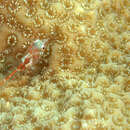Diagnostic Description
provided by Fishbase
Description: Dorsal fin XXI, 13; anal fin II, 22; pectoral rays 14. Head small and rounded; snout short and blunt; preoperculomandiblar series: commissural 1, occipital 3, temporal none, lateral 1, preopercular 6, mandibular 5; supraorbital pores: frontal 3, commissural 1, nasal 1; infraorbital pores: postorbital 3, suborbital 4; nasal cirrus simple, shorter than orbit length; jaws equal and slightly obliquely descending posteriorly. Body compressed and elongated (Ref. 47007). No supraorbital cirri (Ref. 26938).
- Recorder
- Grace Tolentino Pablico
Life Cycle
provided by Fishbase
Females lay eggs in tube cavities occupied by breeding males (Ref. 51514).
- Recorder
- Crispina B. Binohlan
Morphology
provided by Fishbase
Dorsal spines (total): 21; Dorsal soft rays (total): 13; Analspines: 2; Analsoft rays: 22
- Recorder
- Grace Tolentino Pablico
Trophic Strategy
provided by Fishbase
Exhibits very high microhabitat specifity, the only blenny found in holes of living corals. These holes were created by the serpulid worm Spirobranchus giganteus and when they are gone, the cavities in live scleractinian corals are occupied by black-headed breeding males. Females, non-breeding males, and immatures, are often found on the sea fan coral Gorgonia ventalina particularly at daytime. At night they spend their quiescent period on surface of rubble, coralline algae, live coral, or other substrate at the base of the sea fans. They may also be found near the cavities of the mature males. The females deposit their eggs to be fertilized and brooded by the males in the cavities. The pale non-breeding males occupy a cavity within few minutes after a resident mature male is disturbed or removed (by collectors) or when new cavities are available when a serpulid worm dies. Unlike in other chenopsides, there is no apparent intraspecies competition for quality shelter based on food availability but this species occupy all available cavities from upper to lower branches of the coral and from shallow water reef crests down to drop-offs 30 m deep. Also there was no interspecific competition since they are the only species in the Western Carribean able to routinely exploit live coral habitat while most other fishes compete on dead coral shelter sources. They may also be found in those coral rubble but does not actively compete there for space. E. diaphna may also inhabit sea fans based on a single reported occurrence from the eastern Caribbean but greater number of individuals of E. pricei spend more of their life history with sea fans. Such fish association with sea fans are common among gobies in the Indo-Pacific but are poorly known in the Atlantic (Ref. 51514).
- Recorder
- Kristine Elaine Paz Olisa
Biology
provided by Fishbase
Found on surface of hard corals and sea fans on coral reefs, from shallow reef crests to drop offs at depths to 30 m. Exhibit greater habitat specificity than other chaenopsids. Spirobranchus giganteus. Females and immature males move about on surface of or near live corals, particularly sea fans. Breeding males are particularly found only in tubes abandoned by serpulid worms Spirobranchus giganteus. These probably controls their population size (Ref. 51514).
- Recorder
- Grace Tolentino Pablico
Emblemariopsis pricei
provided by wikipedia EN
The seafan blenny (Emblemariopsis pricei) is a species of chaenopsid blenny found in Glover's Reef, on the coasts of Belize and Honduras, in the western Atlantic ocean. It can reach a maximum length of 2.9 centimetres (1.1 in) SL.[2] The specific name honours the premier of Belize at the time Greenfield was give permission to collect specimens in Bleize, George C. Price (1919-2011).[3]
References
- Greenfield, D.W., 1975 (31 Dec.) Emblemariopsis pricei, a new species of chaenopsid blenny from Belize. Copeia 1975 (no. 4): 713–715.

- license
- cc-by-sa-3.0
- copyright
- Wikipedia authors and editors
Emblemariopsis pricei: Brief Summary
provided by wikipedia EN
The seafan blenny (Emblemariopsis pricei) is a species of chaenopsid blenny found in Glover's Reef, on the coasts of Belize and Honduras, in the western Atlantic ocean. It can reach a maximum length of 2.9 centimetres (1.1 in) SL. The specific name honours the premier of Belize at the time Greenfield was give permission to collect specimens in Bleize, George C. Price (1919-2011).
- license
- cc-by-sa-3.0
- copyright
- Wikipedia authors and editors

